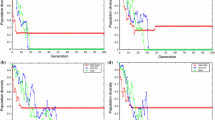Abstract
Random individual initialization tends to generate too many eccentric and homogeneous individuals which cause slow and premature convergence. It needs many operations (selection strategy, incest prevention and mutation) to fix, which consume too much computation and lose many good genes. The proposed complementary-parent strategy initializes every other pair of parents with dynamically or statically complementary chromosomes (such as 010101…0101 and 101010…1010). Crossover of every generation is only performed between the offspring from the same parents, during which the parents are completely replaced by their own children. Higher population diversity is got without gene lost at all, by which search ability is enhanced. Incest prevention, selection strategies and mutation are unnecessary and consequently cancelled (so it is named pseudo genetic algorithm). As indicated by the simulation results, the speed of elitist search is accelerated greatly and computation complexity is reduced by half.




Similar content being viewed by others
References
Holland JH (1975) Adaptation in natural and artificial systems. University of Michigan Press, Ann Arbor
Jong D (1975) Analysis of behaviour of a class of genetic adaptive systems. PhD Thesis, Department of Computer and Communication Science, University of Michigan, Ann Arbor
Adler D (1993) Genetic algorithms and simulated annealing: a marriage proposal, neural networks. In: IEEE international conference on 28 March–1 April 1993, 2:1104–1109
Morimoto T, Takeuchi T, Hashimto Y (1993) Growth optimization of plant by means of the hybrid system of genetic algorithm and neural network. In: Proceedings of 1993 international joint conference on neural networks
Srinivas M, Patnaik LM (1994) Adaptive probabilities of crossover and mutation in genetic algorithms. IEEE Trans Syst Man Cybern 24(4):656–667. doi:10.1109/21.286385
Mahfoud SW (1995) Niching methods for genetic algorithms. PhD thesis, University of Illinois
Harik G, Lobo F, Goldberg DE (1997) The compact genetic algorithm, IlliGAL Report 97006. University of Illinois, Illinois Genetic Algorithms Laboratory, Urbana-Champaign
Xu Z, Gao Y (1997) Characteristic analysis and prevention on premature convergence in genetic algorithms. Sci China Ser E Technol Sci 40(2):113–125. doi:10.1007/BF02916943
Rudolph G (1994) Convergence analysis of canonicalal genetic algorithms. IEEE Trans Neural Netw 5(1)
Eshelman U, Schaffer JD (1991) Preventing premature convergence in genetic algorithms by preventing incest. In: Proceedings of the fourth international conference on genetic
Goldberg DE (1989) Genetic algorithms in search. Optimization and machine learning. Addison-Wesley, Reading
Goldberg DE, Deb K (1991) A comparative analysis of selection schemes used in genetic algorithms. In: Rawlins GJE (ed) Foundatins of genetic algorithms. Morgan Kaufmann, San Mateo, pp 69–93
Tsutsui S, Ghosh A (2003) Effects of adding perturbations to phenotypic parameters in genetic algorithms for searching robust solutions. In: advances in evolutionary computing: theory and applications. Springer, New York
Xinchao Z (2005) A greedy genetic algorithm for unconstrained global optimization. J Syst Sci Complex 18(1):102–110
Pankratz G (2005) A grouping genetic algorithm for the pickup and delivery problem with time windows. Spectrum 27(1):21–41. doi:10.1007/s00291-004-0173-7
Yokoyama N, Suzuki S (2005) Modified genetic algorithm for constrained trajectory optimization. J Guid Control Dyn 28(1):139–144. doi:10.2514/1.3042
Tu Z, Lu Y (2004) A robust stochastic genetic algorithm (StGA) for global numerical optimization. IEEE Trans Evol Comput 8(5):456–470. doi:10.1109/TEVC.2004.831258
Wei L, Zhao M (2005) A niche hybrid genetic algorithm for global optimization of continuous multimodal functions. Appl Math Comput 160(3):641–649
Liu D, Cao YD (2006) A chaotic genetic algorithm for fuzzy grid job scheduling. In: International conference on computational-intelligence and security, Guangzhou, People’s Republic of China, Pts 1 and 2, pp 320–323
Tan KC, Wang ML, Peng W (2005) A P2P genetic algorithm environment for the internet. Commun ACM 48(4):113–116. doi:10.1145/1053291.1053297
Zeqing Y, Libing L, Zhihong T, Weiling L, Control Conference (2008). Application of adaptive genetic algorithm in flexible inspection path planning. In: 2008 Chinese control conference (CCC), pp 75–80
Hinterding R, Michalewicz Z, Eiben AE (1997) Adaptation in evolutionary computation: a survey, evolutionary computation. In: IEEE international conference on 13–16 April 1997, pp 65–69
Herrera F, Lozano M, Sánchez AM (2005) Hybrid crossover operators for real-coded genetic algorithms: an experimental study, soft computing—a fusion of foundations. Methodol Appl 9(4):280–298
Drezner Z (2005) A distance based rule for removing population members in genetic algorithms. 4OR: Q J Oper Res 3(2):109–116
Turkcan A, Akturk MS (2003) A problem space genetic algorithm in multiobjective optimization. J Intell Manuf 14(3–4):363–378. doi:10.1023/A:1024605927329
He Y, Chu F, Zhong B (2002) A hierarchical evolutionary algorithm for constructing and training wavelet networks. Neural Comput Appl 10(4):357–366. doi:10.1007/s005210200008
Sun H, Lam K-Y, Chung S-L et al (2005) Efficient vector quantization using genetic algorithm. Neural Comput Appl 14(3):203–211. doi:10.1007/s00521-004-0455-7
Dracopoulos DC, Jones AJ (1994) Neuro-genetic adaptive attitude control. Neural Comput Appl 2(4):183–204 C45
Paul RJ, Chanev TS (1997) Optimising a complex discrete event simulation model using a genetic algorithm. Neural Comput Appl 6(4):229–237. doi:10.1007/BF01501509
Lee M, Joo S, Kim HS (2004) Realization of emergent behavior in collective autonomous mobile agents using an artificial neural network and a genetic algorithm. Neural Comput Appl 13(3):237–247. doi:10.1007/s00521-004-0410-7
Eshelman LJ, Schaffer JD (1993) Real-coded genetic algorithms and interval-schemata. Found Genet Algorithms 2:187–202
Radcliffe NJ (1990) Genetic neural networks on MIMD computers. PhD thesis, University of Edinburgh, Edinburgh
Ono I, Kobayashi S (1997) A real-coded genetic algorithm for function optimization using unimodal normal distribution crossover. In: Proceedings of 7th international conference on genetic algorithms, pp 246–253
Barrios D, Carrascal A, Manrique D, Ríos J (2003) Cooperative binary-real coded genetic algorithms for generating and adapting artificial neural networks. Neural Comput Appl 12(2):49–60. doi:10.1007/s00521-003-0364-1
Hamming RW (1950) Error detecting and error correcting codes. Bell Syst Tech J 29:147–160
Author information
Authors and Affiliations
Corresponding author
Rights and permissions
About this article
Cite this article
Chen, Q., Zhong, Y. & Zhang, X. A pseudo genetic algorithm. Neural Comput & Applic 19, 77–83 (2010). https://doi.org/10.1007/s00521-009-0237-3
Received:
Accepted:
Published:
Issue Date:
DOI: https://doi.org/10.1007/s00521-009-0237-3




